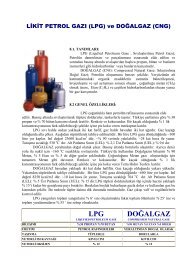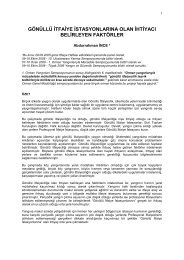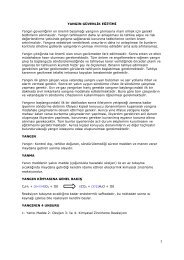buradan - Yangın
buradan - Yangın
buradan - Yangın
You also want an ePaper? Increase the reach of your titles
YUMPU automatically turns print PDFs into web optimized ePapers that Google loves.
Some users don’t use sufficient length Anchor bolts, they use 7-10<br />
cm bolts, the min required must be 15-50 cm depend on pump<br />
power, weight…etc.<br />
Also don’t try to lift the pump to match suction line using steel<br />
sheets, or bars, or welding metal bars under the pump base, this<br />
can lead to high vibration.<br />
In all times must use Grout materials after finishing installation, this<br />
will reduce any vibration.<br />
1.8. Discharge Line<br />
Many users use the pump discharge flange as guide to the<br />
discharge line, without taking of consideration NFPA min. pipe<br />
size, which can result of losing the getting water up to 150% of<br />
listing capacity.<br />
1.9. Relief Valve<br />
Many users have three mistakes, using relief valve with electric<br />
fire pump, which is bad design, because this mean using the relief<br />
valve as pressure control valve, second mistake using the relief<br />
valve with diesel engine while the pump shut-off pressure X1.22,<br />
plus suction pressure is less than system working pressure, as this<br />
mean spending money, you don’t need to spend, third installation<br />
the relief valve in wrong location like on the system piping, which<br />
lead that the relief valve will be most of the time subject to system<br />
pressure which lead to losing the sensitivity of the valve, the right<br />
location if after the pump discharge flange, and before the checkvalve.<br />
1.10. Flow Meter<br />
Many users don’t follow the NFPA20 guide of the location of flow<br />
meter, or forget to add. Control valve after the flow meter to control<br />
the flow to take the measurement at different flow/head points.<br />
Preferred Arrangement for Measuring Fire Pump Water Flow with<br />
Meter for Multiple Pumps and Water Supplies. Water is permitted<br />
to discharge to a drain or to the fire pump water source.<br />
BİLDİRİLER KİTABI TÜYAK<br />
PROCEEDINGS BOOK 2009<br />
1.11. Fuel Tank<br />
Some client use galvanized steel, or copper pipes, which lead to<br />
having abrasive partials in the fuel, and can affect the fuel pump<br />
performance, only black steel pipes is recommended.<br />
Also height of the fuel tank, few users either will put it under the<br />
base, which lead to risk of entering air inside the fuel intake, or high<br />
level than enough, which lead to fuel leakage out of the engine fuel<br />
nozzle, NFPA state clearly the height of the tank.<br />
Figure 11.<br />
Figure 10. Figure 12.<br />
1.12. Sensing Lines<br />
One of the common mistakes using plastic, black steel or<br />
galvanized steel pipes, while the only approve is brass, or stainless<br />
steel tubes.<br />
Other mistakes, mixing materials, like using brass tubes, with SS<br />
fittings.<br />
Common mistake putting valve between the discharge line, and<br />
sensing line for service purpose, which some time lead to closing<br />
the valve, and forget, which lead that the pump will not start.<br />
Or using one line to supply the pressure to all pressure switches,<br />
NFPA required one sensing line for each pump.<br />
TÜYAK 2009<br />
5





